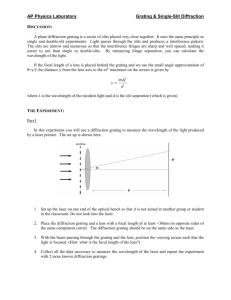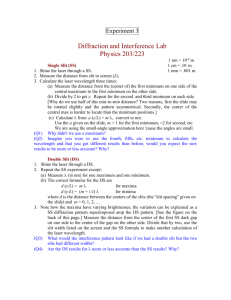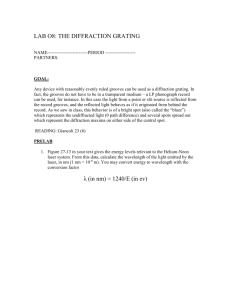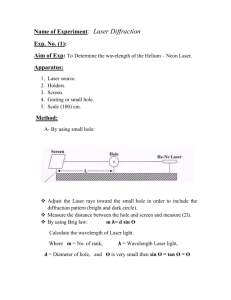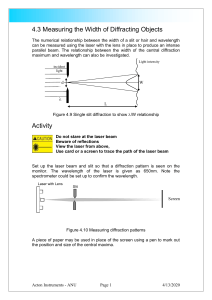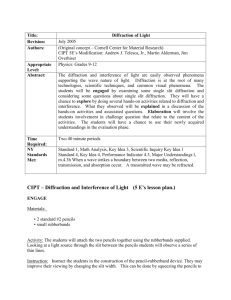Diffraction Activities
advertisement
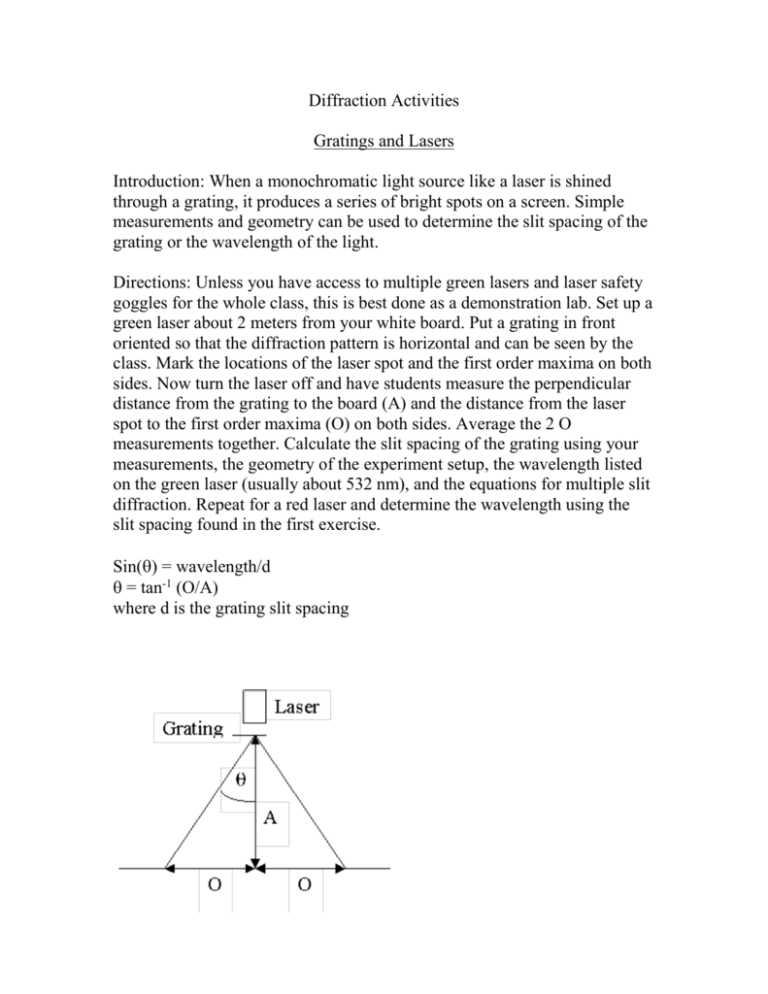
Diffraction Activities Gratings and Lasers Introduction: When a monochromatic light source like a laser is shined through a grating, it produces a series of bright spots on a screen. Simple measurements and geometry can be used to determine the slit spacing of the grating or the wavelength of the light. Directions: Unless you have access to multiple green lasers and laser safety goggles for the whole class, this is best done as a demonstration lab. Set up a green laser about 2 meters from your white board. Put a grating in front oriented so that the diffraction pattern is horizontal and can be seen by the class. Mark the locations of the laser spot and the first order maxima on both sides. Now turn the laser off and have students measure the perpendicular distance from the grating to the board (A) and the distance from the laser spot to the first order maxima (O) on both sides. Average the 2 O measurements together. Calculate the slit spacing of the grating using your measurements, the geometry of the experiment setup, the wavelength listed on the green laser (usually about 532 nm), and the equations for multiple slit diffraction. Repeat for a red laser and determine the wavelength using the slit spacing found in the first exercise. Sin() = wavelength/d = tan-1 (O/A) where d is the grating slit spacing Measuring CD Pit Spacing Introduction: A CD consists of a reflective surface with pits “burned” into it. As the laser scans the CD, the pit prevents its reflection which is read as a 0, a reflection is a 1. This allows data to be stored and read in digital form. The pits form a spiral that is read from the inside of the CD outward. The spacing from one spiral is uniform throughout the CD and can be determined because the CD acts like a grating. If a red laser is used it is safe and cheap enough for students to do this activity. Reflective Spot Pit 1 0 1 0 1 0 1 0 1 0 Close-up of a CD Directions: Open the CD case and put the CD so that the label is facing inward. The case then acts as a stand. Shine the laser so it has a 45o incident angle to the CD. If the laser hits the CD even with the center hole it will produce a horizontal diffraction pattern. Place a white sheet vertically so that it is parallel to the laser and catches the main reflection and first order maximum of the diffraction pattern. Measure the distance from the CD to the sheet (A) and the distance between the main reflection and the first order diffraction (O). The equations to calculate d are the same as the multiple slit diffraction equations used in the grating activity above. See the below diagram for the geometry of the setup. You also can do this activity with a DVD. The closer pit spacing reveals why DVDs store more data. Measuring Hair Thickness Introduction: Diffraction and interference effects are used to make precise measurements of very small distances, such as the pit spacing of a CD. Another interesting application of this is measuring the thickness of a hair. Tape a hair across a hole that is cut in a piece of cardboard so that it is taught. Place the hair so it is in front of the laser. The hair acts as a double slit. The geometry and equations are the same as the grating activity above. The only difference is that you will need to have the laser beam travel the length of the room to obtain a good interference pattern. The pattern will not be as well defined, measure from the center of the pattern to the center of the first bright spot. Create a data table fro the whole class and compare the different hair thicknesses.



